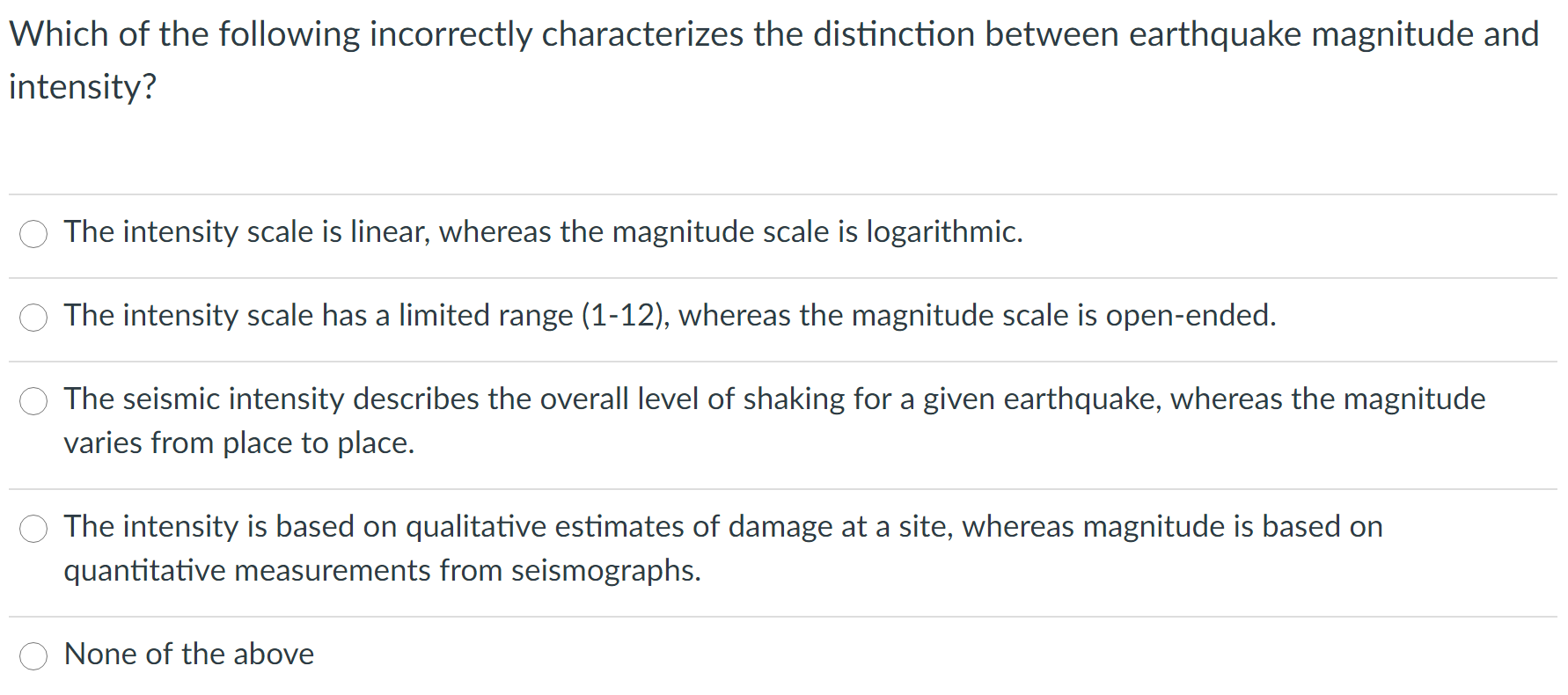Intensity Earthquake Magnitude Scale | The former measures the energy released at the source of the earthquake. Every alternate day one comes across news channels flashing news of an earthquake of some magnitude occurring somewhere in the world. They are distinguished from seismic magnitude scales, which measure the magnitude or overall strength of an earthquake, which may. All three scales provide useful information in mercalli intensity of an earthquake of magnitude 1.0 to 2.0 is recorded if the earthquake was barely noticeable. Learn how the richter scale measures magnitude and the mercalli scale measures intensity of an earthquake. There often seems to be no end and when news announcers mention the richter scale seismologists the world over begin gnashing their teeth. It measures the total energy released by an earthquake. There are other magnitude scales, like the moment magnitude, body wave magnitude, surface wave magnitude, and wave energy magnitude. Play with the tool to contemplate and admire mother earth's natural strength, or scroll down to read about the most powerful earthquakes the world has ever seen. A familiar analogy to help. A familiar analogy to help. In this video lecture, measures of earthquake i.e. Magnitude and intensity both are calculated when an earthquake occurs. Magnitude and intensity measure various characteristics of earthquake. Intensity count is xii for. An earthquake intensity scale can be used in two different ways. These are distinguished from seismic intensity scales that categorize the intensity or severity of ground. The richter magnitude scale) measures the amount of energy released at the earthquake's epicenter. The moment magnitude scale is another earthquake measurement scale used by some seismologists. For example, a magnitude 6.0 earthquake releases about. The scale can go up to as high as 9.5 (this was the largest ever recorded in chile in 1960). Magnitude and intensity measure different characteristics of earthquakes. A logarithmic scale means a magnitude increase of 1 relates to an energy increase by a factor of 10. The magnitude scale portrays energy logarithmically to approximately base 32. Richter of the california institute of technology as a mathematical device to compare the size of earthquakes. The scale can go up to as high as 9.5 (this was the largest ever recorded in chile in 1960). Earthquake magnitude and earthquake intensity are commonly mistaken for one another. A logarithmic scale means a magnitude increase of 1 relates to an energy increase by a factor of 10. Seismic intensity scales categorize the intensity or severity of ground shaking (quaking) at a given location, such as resulting from an earthquake. While seismic magnitude is interesting, seismic intensity is more important: Earthquakes are also classified in categories ranging from minor to great, depending on their magnitude. Seismic magnitude scales are used to describe the overall strength or size of an earthquake. Earthquake shaking is typically measured as an acceleration; The magnitude scale portrays energy logarithmically to approximately base 32. Learn how the richter scale measures magnitude and the mercalli scale measures intensity of an earthquake. At least three seismograms must be used to calculate where the epicenter is located. The mercalli intensity scale describes earthquake intensity. There often seems to be no end and when news announcers mention the richter scale seismologists the world over begin gnashing their teeth. What the mercalli intensity scale does, is it measures the destructiveness of an earthquake by looking at the amount of ground shaking and the damage that the earthquake has done. The moment magnitude scale is the favored method of measuring earthquake magnitudes. The richter magnitude scale , or more correctly local magnitude m l scale, assigns a single number to quantify the amount of seismic energy released by an earthquake. Its magnitude and intensity are defined and differentiated. Magnitude and intensity measure various characteristics of earthquake. Learn how the richter scale measures magnitude and the mercalli scale measures intensity of an earthquake. The mercalli intensity scale describes earthquake intensity. The scale can go up to as high as 9.5 (this was the largest ever recorded in chile in 1960). The mercalli intensity scale describes earthquake intensity. Richter of the california institute of technology as a mathematical device to compare the size of earthquakes. Magnitude and intensity both are calculated when an earthquake occurs. The richter magnitude scale was developed in 1935 by charles f. Play with the tool to contemplate and admire mother earth's natural strength, or scroll down to read about the most powerful earthquakes the world has ever seen. Learn about earthquake magnitude and intensity scales used around the world! Scales of earthquake magnitude (the total energy of a quake) came later, the result of many advances in seismometers and decades of data collection. Over the past century, scientists have developed several ways of measuring earthquake intensity. The moment magnitude scale is another earthquake measurement scale used by some seismologists. Seismic intensity scales categorize the intensity or severity of ground shaking (quaking) at a given location, such as resulting from an earthquake. While seismic magnitude is interesting, seismic intensity is more important: Earthquakes are also classified in categories ranging from minor to great, depending on their magnitude. Perhaps no seismic subject is as irksome to seismologists as discussions of earthquake size.

Magnitude measures the energy released at the source of the earthquake earthquake magnitude scale. Intensity count is xii for.
Intensity Earthquake Magnitude Scale: Higher magnitude earthquakes cause more violent shaking, which in turn typically cause higher intensity.
0 comments:
Post a Comment